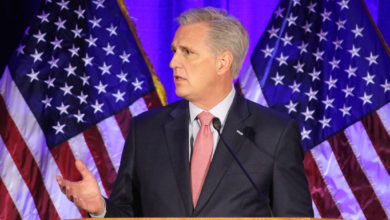You do not need a degree in economics to know that the U.S. economy is in deep crisis. Nearly all talk in the capitalist press highlights Wall Street’s woes.
|
The number of food stamp recipients is a telling statistic. The Congressional Budget Office estimates that 28 million people in the United States will receive food stamps from the government in the next fiscal year. This is the highest level since the program began.
The increase—up from 26.5 million in 2007—means that over 9 percent of the U.S. population will rely on government food assistance to survive.
The rise is dramatic but not unexpected. The figure has risen steadily since 2000, with a major spike in the last year. From December 2006 to December 2007, the number of food stamp recipients grew in more than 40 states. In Arizona, Florida, Maryland, Nevada, North Dakota and Rhode Island, one-year growth was 10 percent or more. (New York Times, March 31)
One in eight Michigan residents currently receives food stamps. “Our caseload has more than doubled since 2000, and we’re at an all-time record level,” Maureen Sorbet, spokeswoman for the Michigan Department of Human Services, told the New York Times.
The increased dependence on food stamps starkly illustrates how the capitalist economic crisis hurts working-class people where they are most vulnerable. The crisis is pushing millions into poverty at a time when the gap between rich and poor is higher than ever.
A brief history
The food stamp program provides monthly benefits to eligible low-income families that can be used to purchase food. It is considered an entitlement program—a social benefit provided by the government on a need basis.
A limited food stamp program went into effect from 1939 to 1943 in response to the sharp 1937-1938 economic downturn that tailed the Great Depression.
Although not officially part of the New Deal, liberal politicians saw that the government could get rid of “unmarketable” food and provide temporary relief for the throngs of unemployed workers. The first food stamp program was a pressure valve designed to undermine anti-capitalist sentiments in the workers’ movement. Nearly 20 million people benefited from the program in four years.
Once the country fully mobilized for World War II, the glut of surplus food disappeared. Millions of working men became paid soldiers, millions of women entered the workforce, and consumption increased. At the same time, food production slowed as resources were directed to the war drive, and rationing began. The imperialists’ solution to mass food insecurity created by the capitalist economic crisis had been short lived.
President John Kennedy initiated the next food stamp program in 1961. The war boom was long gone, farmers were producing a surplus, and still people were going hungry, unable to afford food. The government intervened by making food more affordable for a section of the country’s poorest people, giving them greater access to the food commodity market.
As the civil rights movement spread like wildfire through the South in the early 1960s, so too did a broad exposé of poverty in the United States. The 1962 book “The Other America,” written by social-democratic critic Michael Harrington, created a political sensation by documenting the extraordinary levels of hunger and malnutrition in the country.
The renewed food stamp program was made permanent in 1964 under President Lyndon Johnson and extended in 1974 under President Richard Nixon. It is overseen by the Department of Agriculture, funded by the federal government and administered at the state and local levels.
Poor enough to eat?
The program suffered huge cutbacks under Ronald Reagan in the early 1980s and under Bill Clinton, who made good on his promise to the right wing to “end welfare as we know it” in 1996. Large numbers of workers lost the food stamps they relied on, because they were deemed “not poor enough” following Clinton’s “reforms.”
Only the poorest people are eligible for food stamps. Recipients must have few assets and incomes lower than 130 percent of the ridiculously low “official” poverty line. A family of four must earn less than $27,560 per year. Thus, as the National Priorities Project reported in October 2007, half of all low-income people do not receive food stamp benefits.
Stamp recipients can purchase, on average, $100 in food per family member each month. Soaring food and gasoline prices across the United States—propelled by the dollar’s decline—have diminished the purchasing power of the stamps’ meager value. Workers are being forced to spend a higher percentage of their income on food and gas.
Figures from the U.S. Department of Agriculture—the government agency that doles out food stamps—show that average monthly food costs are often more than double the amount covered by food stamps. (Official USDA Food Plans, February 2008) The cost of feeding a low-income family of four has risen 6 percent in one year.
Things are likely to get worse. The International Monetary Fund has said that the U.S. housing market meltdown has triggered the worst economic crisis since the Great Depression. Billionaire capitalist George Soros agreed: “We are in a period of financial wealth destruction,” he told The Australian.
The IMF and Soros speak from the imperialists’ point of view. They care only about the well-being of the capitalist system. This is why the U.S. government and Federal Reserve endlessly bail out financial markets and rescue parasitic financial giants like Bear Stearns. This is why nearly $800 billion is spent yearly to fund imperialist war, while only $36 billion goes to feed the poor.
These government priorities serve no social purpose, but they do help ensure the continued supremacy of the capitalist ruling class. Neither the Federal Reserve nor the government will bail workers out of poverty, hunger, unemployment or homelessness. The measly Bush-Congress “stimulus package” proves this all too true.
What is left for those most oppressed by capitalism?
Social welfare programs are not enough. Most are on the chopping block or have been eliminated altogether. For example, Bush’s 2009 budget eliminates funding for the Commodity Supplemental Food Program—a critical nutrition program for low-income seniors and women with children.
Food aid and other programs that serve workers’ needs are viewed by the capitalists as unnecessary expenses dictated by the class struggle between rich and poor. In times of intense struggle, capitalists offer more to stave off the possibility of increased militancy. In times of relative peace, cutbacks are the order of the day.
Entitlement programs are necessary for workers under this system, but programs alone will not alleviate hunger or the root causes of inequality. They put a band-aid on the conditions of poverty.
Socialists understand this truth. Heating up the class struggle to expose the incurable contradictions of capitalism is a central task for the working-class movement.







